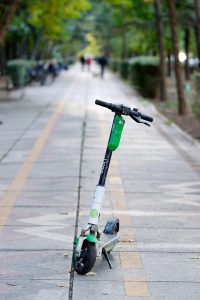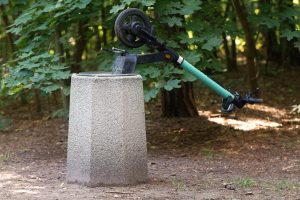Choosing the right scooter for various terrains can be quite a challenge, especially when you’re trying to meet your adventurous needs. Finding a scooter that’s both practical and fun can make all the difference.
We understand that scooters are not just toys. They’re vehicles of joy and exploration. They want to zoom down pavements, navigate gravel paths in parks, or even venture off-road. That’s why it’s essential to choose the right scooter that suits all types of terrains and ensures high quality safety features at the same time.

When choosing a scooter, you’ll want to consider the terrain they’ll be using it on. You may need a scooter with bigger and more durable wheels for off-roading, or an ultra-portable model that’s easy to carry and store when using public transport. Understanding your terrain needs, as well as factors like wheel size, material, durability, weight, and portability, will help you make a good choice when buying a scooter. Front and rear suspensions might also be a useful feature for more rugged terrains. We’ll also discuss additional features that may enhance your scooter riding experience.
Key Takeaways
Selecting the perfect scooter for varied surfaces can seem daunting, but here are some helpful tips that can guide you. It’s essential to know your terrain and weigh factors like the scooter’s type, wheel size, materials, sturdiness, weight, and extra features. This knowledge can significantly enhance your scooter riding experience!
When choosing the ideal scooter, keep in mind the various types available: electric scooters, kick scooters, self-balancing scooters, hoverboards, and Razor scooters. Each scooter comes with its own set of characteristics, like weight, speed, and battery longevity. However, it’s best to steer clear of gas-powered scooters, as they aren’t well-suited for diverse terrains.
Scooter Terrain Needs
Before plunging into the diverse scooter market, first recognize the terrain you’ll frequently encounter, as this can dramatically influence your riding experience. Will you be zipping through city streets, navigating uneven country trails, or both? Knowing this can dictate whether you opt for an off-road electric scooter, an all-terrain mobility scooter, or a city commuter kick scooter. Uneven terrains demand attention to ride quality, sufficient ground clearance, and features ensuring stability and a smooth scooter journey. For those who are more adventurous and wish to conquer challenging terrains, dedicated off-road electric scooters might be your best bet. While the market is brimming with all-terrain electric scooters, remember that gas-powered scooters are not the focus of this guide.
Scooter Types
When planning to purchase a scooter, it’s important to consider the advantages and drawbacks of the various types available. These include kick scooters, electric scooters, and other options. Aside from functionality, its aesthetic is also important.

It’s also important to keep your price range in mind, as quality doesn’t always mean expensive. Additionally, the wheel size and material should be taken into account, as certain wheels are better suited for various terrains.
Scooter Wheel Size And Materials
When it comes to the thrill of scootering, don’t underestimate the impact of wheel size and material on your ride’s smoothness and control. Choosing larger wheels can improve stability, making them perfect for rough terrains. Material resilience is also crucial for wheel maintenance; harder materials last longer.
When choosing a scooter, it is important to consider wheel size, wheel material, durability, and build quality. Larger wheels provide more stability and better control on rough terrains, while harder materials are more resilient and last longer. Kick scooters, for example, may have varying levels of durability based on the material and construction. Additionally, it’s wise to take a close look at the scooter’s durability and build quality.
Scooter Durability
When it comes to scooters, durability and build quality shouldn’t be overlooked. Consider these factors: scooter maintenance, price range, and the material used. A scooter with good durability and build quality will require less upkeep, saving you time and money. Additionally, choose a scooter that should be able to handle various terrains, and its weight and portability should be taken into account.
Scooter Weight And Portability
When it comes to choosing a scooter, weight, and portability are essential factors to consider. It’s important to check the weight capacity, especially if you plan to use it off-road. A lightweight, portable scooter model will make transitions smoother.

Gas-powered scooters should be avoided, as they have their own set of considerations which aren’t discussed in this article.
Choose Additional Scooter Features
As we delve further into our discussion, let’s not forget to consider some additional features that can greatly enhance your child’s scooter experience. Adjustable handlebars are a great investment as they allow the scooter to grow with your kid, ensuring prolonged use. Suspension systems and brake systems also play vital roles in providing a smoother scooter ride and ensuring safety, respectively, so we’ll explore these areas in detail too.
Adjustable Handlebars
Adjustable handlebars are a must-have. Not only do they provide grip comfort and safety, but they also give you the flexibility to adjust the height. If you’re looking for the perfect scooter for your family, make sure to choose one with adjustable handlebars. After all, it’s the perfect way to ensure maximum comfort and safety while riding a scooter.
As we transition to discussing suspension systems, keep in mind the many types of scooters, such as kick scooters, electric scooters, and foldable scooters, all of which come with various features such as adjustable handlebars, wheels, brakes, and suspension systems. Additionally, there are also attributes and values associated with each type of scooter, such as size, weight, and speed. With these features and attributes in mind, you can make an informed decision about choosing the best scooter for your needs.
Suspension Systems
Riding smoothly, even on the beaten track, is possible with an efficient suspension system for safe and comfortable rides. Suspension types vary, from spring absorbers to hydraulic systems with shock absorbers that offer a cushioned ride. Apollo scooters, among other brands, prioritize shock absorption and utilize both drum brakes and other braking systems for optimal safety. With the right components, such as dual motors and adequate battery power, scooters can achieve a top speed that’s complemented by a powerful motor. Suspension, battery power, and brake systems are crucial considerations. Regular scooter maintenance, especially of the braking and suspension systems, ensures the longevity and performance of the scooter, allowing for a smooth and comfortable ride.
Brake Systems
When it comes to your family’s safety in riding a scooter, don’t underestimate the importance of a reliable brake system. Hand-operated brakes offer more control, while rear-fender brakes are user-friendly for beginners.
Regular brake maintenance ensures they work effectively across various terrains. Hand-operated brakes provide control and precision, while rear-fender brakes are designed for easy use. But remember, a well-functioning brake system is as essential as the helmet you wear! Also, consider maintenance, control, and user-friendliness. Keeping up with regular scooter maintenance is key to maintaining the reliability of the brake system.
Conclusion
Choosing the right scooter for various terrains can be a tad challenging. It’s all about understanding your terrain, considering the scooter type, wheel size, material, durability, weight, and extra features. It’ll make a world of difference in their scooter riding experience!
In addition to choosing the right scooter for various terrains, make sure you’re aware of the various types, like electric scooters, kick scooters, self-balancing scooters, hoverboards, and Razor scooters, as well as their attributes and values, including weight, speed, and battery life.
Frequently Asked Questions (FAQs):
What Is An All-Terrain Scooter?
All-terrain scooters can handle trails and pavement. Bigger, stronger scooter tires enhance traction and stress absorption. To withstand the demands of rough terrain, the frame may also have additional characteristics like improved suspension. The frame is often more durable and may include additional features like enhanced suspension to handle the demands of uneven terrains. If you are seeking versatility in your ride, this type of scooter is an excellent choice.
What Is An Off-Road Mobility Scooter?
Off-road mobility scooters are developed for disabled individuals. They can navigate grassy fields, uneven ground, and dirt roads that ordinary mobility scooters cannot. These models are particularly beneficial for people who wish to maintain an active lifestyle despite mobility limitations.
What Is The Difference Between Off-Road And All-Terrain Scooters?
Off-road scooters are specifically designed to handle rugged and challenging terrains, such as rocky trails, mud, and dense forests. They often possess more robust suspension systems and may have a heavier build. In contrast, all-terrain scooters are versatile and designed to transition smoothly between paved streets and milder off-road conditions. While both types can navigate non-paved terrains, off-road scooters are generally more equipped for extreme terrains, whereas all-terrain scooters balance urban and light off-road use. When it comes to making a choice, the best scooter for you will depend on your specific needs.
What Is The Difference Between Street And Stunt Scooters?
Street scooters are designed for casual riding and commuting on paved terrains. They prioritize comfort and efficiency. On the other hand, stunt scooters are built for tricks and jumps, featuring a reinforced design and shorter deck for better maneuverability, and often lack adjustable handlebars to ensure sturdiness during tricks. One should carefully choose a scooter based on their intended use and requirements.
What Is An Electric 4-Stroke Scooter?
4-stroke e-scooters are confusing. 4-stroke engines use combustion, while electric scooters use batteries. 4-stroke bikes consume less gas and emit less pollution than 2-stroke bikes. Electric scooters do not need 4-stroke engines. To find the right option, you must find a scooter that’s aligned with their needs.
Why Choose All-Terrain Tires?
All-terrain tires, especially on a terrain electric scooter, are chosen because they are flexible. They function superbly both on and off the road, offering a smooth ride even on dirt tracks. Thanks to their design, which often includes electric scooter tires like air-filled tires and pneumatic tires, they have higher traction in a range of conditions, from slippery roads to muddy trails. Off-road tires excel during off-road rides, while the braking system with disc brakes enhances safety. Because of their adaptability, they are perfect for riders who frequently alternate between driving in cities and more difficult paths. Notably, while solid tires might suit city rides, all-terrain tires provide better versatility.
How Many Km Do All-Terrain Tires Last?
The lifespan of all-terrain tires varies based on usage, brand, and maintenance, but generally, they can last between 40,000 and 100,000 km. Factors affecting their longevity include driving habits, road conditions, tire maintenance, and the weight they consistently carry. Understanding the ground clearance of your vehicle can also provide insights into how long the tires might last.
What Advantage Does All-Terrain Have?
All-terrain vehicles and tires’ versatility is their main advantage. They are made to function effectively in various environments, including smooth roads and difficult trails. Because of its adaptability, users can move between various terrains without changing their equipment, which is convenient and frequently advantageous financially. For added convenience, some all-terrain scooters come equipped with a folding mechanism.
Are All-Terrain Tires Good For Rain?
All-terrain tires are typically designed with deeper treads and patterns that effectively channel water away, providing good traction in wet conditions. Their design helps reduce the risk of hydroplaning, making them a reliable choice for rainy weather.
What Does All-Terrain Wheels Mean?
All-terrain wheels refer to wheels designed to handle various terrains and conditions. These wheels are typically more robust, with deeper treads and patterns that can effectively grip smooth and rough terrains. Whether it’s mud, sand, wet roads, or gravel, all-terrain wheels are crafted to provide stability and performance across diverse conditions. The large wheels often contribute to this versatility.
DISCLAIMER (IMPORTANT): This information (including all text, images, audio, or other formats on FamilyHype.com) is not intended to be a substitute for informed professional advice, diagnosis, endorsement or treatment. You should not take any action or avoid taking action without consulting a qualified professional. Always seek the advice of your physician or other qualified health provider with any questions about medical conditions. Do not disregard professional medical advice or delay seeking advice or treatment because of something you have read here a FamilyHype.com.